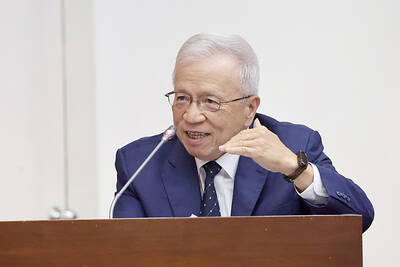China's auto makers experienced a "black May" and a lackluster June of falling sales and bulging inventories, leading to concerns that many may have to drop out of the market, state media reported yesterday.
Auto sales last month slipped 7.1 percent from the month before to 164,852 units for the third monthly decline, the China Business Weekly said, citing figures from the China Association of Automobile Manufacturers (CAAM).
Following an even steeper 20 percent plunge in May, this has caused dealers to worry that the auto market has reached a turning point at which the weakest competitors will be "washed out," the Xinhua news agency said.
"Behind the painful situation lies the chance of [consolidating] the national auto industry, which may take part in global competition afterwards," Xinhua said, citing unnamed experts.
Even the biggest car makers are struggling, as the CAAM said previously that the top five Chinese auto companies recorded a decrease in sales in May from the month earlier ranging between 7.4 and 25.1 percent.
The Chinese government has tried for the past decade to weed out the smallest and most inefficient auto makers, who make up the majority of the 123 companies in the industry.
Many of the lightweights were set up by local governments as prestige projects, but now turn out a tiny number of autos without any of the benefits of economies of scale.
Policy makers in Beijing hope they can groom a handful of large competitive players, and the recently stagnating market may help bring this about.
Year-on-year growth in auto sales has been in abrupt decline over the past few months.
In February, sales were up 76.8 percent from the same month a year earlier, but the growth had dropped sharply to just 2.2 percent in June, according to data from the CAAM.
The result of the decline in auto sales can be seen in the form of large numbers of newly-produced autos collecting dust because they have no buyers.
The auto manufacturing association reported that more than 140,000 sedans were piling up in the inventories as of the end of last month, the China Business Weekly said.
Predictions that the auto industry will have to consolidate have been fueled in recent months by new macroeconomic policies seen as being designed to force revolutionary change.
Concerned about overcapacity in the auto industry, policy makers in Beijing have been engaged in a lengthy effort to curb auto loans.
And last month, the top economic planning body published a long-awaited blueprint for the auto industry, raising the bar for companies wishing to engage in auto manufacturing.
The new regulations include a requirement that any new manufacturing company must have a minimum investment of 2 billion yuan (US$240 million).
One tangible result of declining sales could be a more aggressive price war for high-end autos to attract a dwindling pool of consumers, according to the state media.
"The price war in the low-end is almost finished, which leaves little space for further price cutting, but the medium-end market is different," auto analyst Xie Wei told the China Business Weekly.
"The `war' has just started, and the trend will continue for at least a year."

JITTERS: Nexperia has a 20 percent market share for chips powering simpler features such as window controls, and changing supply chains could take years European carmakers are looking into ways to scratch components made with parts from China, spooked by deepening geopolitical spats playing out through chipmaker Nexperia BV and Beijing’s export controls on rare earths. To protect operations from trade ructions, several automakers are pushing major suppliers to find permanent alternatives to Chinese semiconductors, people familiar with the matter said. The industry is considering broader changes to its supply chain to adapt to shifting geopolitics, Europe’s main suppliers lobby CLEPA head Matthias Zink said. “We had some indications already — questions like: ‘How can you supply me without this dependency on China?’” Zink, who also

At least US$50 million for the freedom of an Emirati sheikh: That is the king’s ransom paid two weeks ago to militants linked to al-Qaeda who are pushing to topple the Malian government and impose Islamic law. Alongside a crippling fuel blockade, the Group for the Support of Islam and Muslims (JNIM) has made kidnapping wealthy foreigners for a ransom a pillar of its strategy of “economic jihad.” Its goal: Oust the junta, which has struggled to contain Mali’s decade-long insurgency since taking power following back-to-back coups in 2020 and 2021, by scaring away investors and paralyzing the west African country’s economy.

BUST FEARS: While a KMT legislator asked if an AI bubble could affect Taiwan, the DGBAS minister said the sector appears on track to continue growing The local property market has cooled down moderately following a series of credit control measures designed to contain speculation, the central bank said yesterday, while remaining tight-lipped about potential rule relaxations. Lawmakers in a meeting of the legislature’s Finance Committee voiced concerns to central bank officials that the credit control measures have adversely affected the government’s tax income and small and medium-sized property developers, with limited positive effects. Housing prices have been climbing since 2016, even when the central bank imposed its first set of control measures in 2020, Chinese Nationalist Party (KMT) Legislator Lo Ting-wei (羅廷瑋) said. “Since the second half of

Taiwan Semiconductor Manufacturing Co (TSMC, 台積電) received about NT$147 billion (US$4.71 billion) in subsidies from the US, Japanese, German and Chinese governments over the past two years for its global expansion. Financial data compiled by the world’s largest contract chipmaker showed the company secured NT$4.77 billion in subsidies from the governments in the third quarter, bringing the total for the first three quarters of the year to about NT$71.9 billion. Along with the NT$75.16 billion in financial aid TSMC received last year, the chipmaker obtained NT$147 billion in subsidies in almost two years, the data showed. The subsidies received by its subsidiaries —